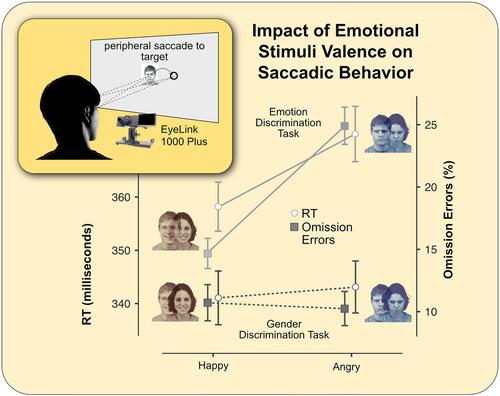当前位置:
X-MOL 学术
›
Ann. N. Y. Acad. Sci.
›
论文详情
Our official English website, www.x-mol.net, welcomes your
feedback! (Note: you will need to create a separate account there.)
The role of task relevance in saccadic responses to facial expressions
Annals of the New York Academy of Sciences ( IF 4.1 ) Pub Date : 2024-09-24 , DOI: 10.1111/nyas.15221 Giovanni Mirabella, Michele Grassi, Paolo Bernardis
Annals of the New York Academy of Sciences ( IF 4.1 ) Pub Date : 2024-09-24 , DOI: 10.1111/nyas.15221 Giovanni Mirabella, Michele Grassi, Paolo Bernardis

|
Recent research on healthy individuals suggests that the valence of emotional stimuli influences behavioral reactions only when relevant to ongoing tasks, as they impact reaching arm movements and gait only when the emotional content cued the responses. However, it has been suggested that emotional expressions elicit automatic gaze shifting, indicating that oculomotor behavior might differ from that of the upper and lower limbs. To investigate, 40 participants underwent two Go/No-go tasks, an emotion discrimination task (EDT) and a gender discrimination task (GDT). In the EDT, participants had to perform a saccade to a peripheral target upon the presentation of angry or happy faces and refrain from moving with neutral ones. In the GDT, the same images were shown, but participants responded based on the posers’ gender. Participants displayed two behavioral strategies: a single saccade to the target (92.7%) or two saccades (7.3%), with the first directed at a task-salient feature, that is, the mouth in the EDT and the nose-eyes regions in the GDT. In both cases, the valence of facial expression impacted the saccades only when relevant to the response. Such evidence indicates the same principles govern the interplay between emotional stimuli and motor reactions despite the effectors employed.
中文翻译:

任务相关性在扫视对面部表情的反应中的作用
最近对健康个体的研究表明,情绪刺激的效价仅在与正在进行的任务相关时影响行为反应,因为只有当情绪内容提示反应时,它们才会影响伸手的手臂运动和步态。然而,有人认为情绪表达会引起自动视线转移,表明动眼神经行为可能与上肢和下肢的行为不同。为了进行调查,40 名参与者接受了两项 Go/No-go 任务,一项情绪辨别任务 (EDT) 和一项性别辨别任务 (GDT)。在 EDT 中,参与者必须在出现愤怒或快乐的面孔时对外围目标进行扫视,并避免用中立面孔移动。在 GDT 中,显示了相同的图像,但参与者根据装扮者的性别做出回应。参与者表现出两种行为策略:对目标的单次扫视 (92.7%) 或两次扫视 (7.3%),第一种针对任务突出特征,即 EDT 中的嘴和 GDT 中的鼻眼区域。在这两种情况下,面部表情的效价仅在与反应相关时影响扫视。此类证据表明,尽管使用了效应器,但相同的原理支配着情绪刺激和运动反应之间的相互作用。
更新日期:2024-09-24
中文翻译:

任务相关性在扫视对面部表情的反应中的作用
最近对健康个体的研究表明,情绪刺激的效价仅在与正在进行的任务相关时影响行为反应,因为只有当情绪内容提示反应时,它们才会影响伸手的手臂运动和步态。然而,有人认为情绪表达会引起自动视线转移,表明动眼神经行为可能与上肢和下肢的行为不同。为了进行调查,40 名参与者接受了两项 Go/No-go 任务,一项情绪辨别任务 (EDT) 和一项性别辨别任务 (GDT)。在 EDT 中,参与者必须在出现愤怒或快乐的面孔时对外围目标进行扫视,并避免用中立面孔移动。在 GDT 中,显示了相同的图像,但参与者根据装扮者的性别做出回应。参与者表现出两种行为策略:对目标的单次扫视 (92.7%) 或两次扫视 (7.3%),第一种针对任务突出特征,即 EDT 中的嘴和 GDT 中的鼻眼区域。在这两种情况下,面部表情的效价仅在与反应相关时影响扫视。此类证据表明,尽管使用了效应器,但相同的原理支配着情绪刺激和运动反应之间的相互作用。






























 京公网安备 11010802027423号
京公网安备 11010802027423号